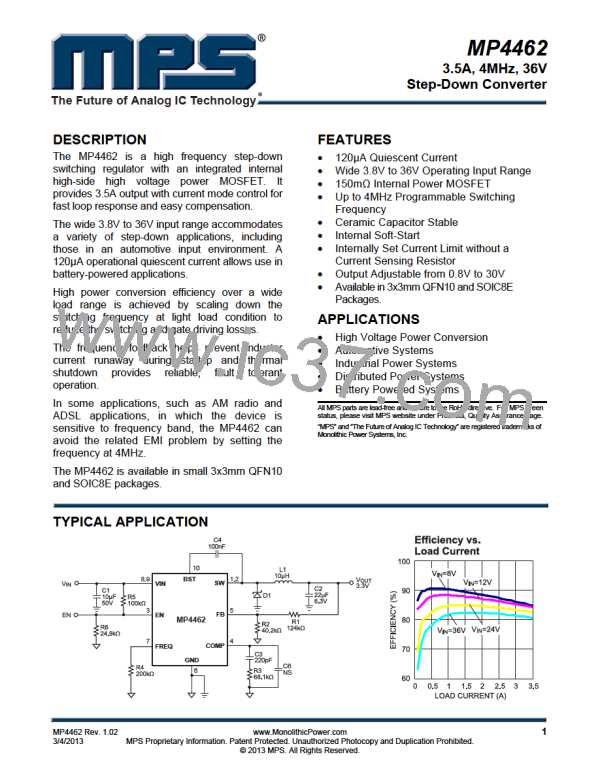MP4462 – 3.5A, 4MHz, 36V STEP-DOWN CONVERTER
OPERATION
The MP4462 is
non-synchronous,
a
variable frequency,
can be enabled and disabled by EN which has
positive logic. Its falling threshold is a precision
1.2V, and its rising threshold is 1.5V (300mV
higher).
step-down switching
regulator with an integrated high-side high
voltage power MOSFET. It provides a single
highly efficient solution with current mode
control for fast loop response and easy
compensation. It features a wide input voltage
range, internal soft-start control and precision
current limiting. Its very low operational
quiescent current makes it suitable for battery
powered applications.
When floating, EN is pulled up to about 3.0V by
an internal 1µA current source so it is enabled.
To pull it down, 1µA current capability is needed.
When EN is pulled down below 1.2V, the chip is
put into the lowest shutdown current mode.
When EN is higher than zero but lower than its
rising threshold, the chip is still in shutdown
mode but the shutdown current increases
slightly.
PWM Control
At moderate to high output current, the MP4462
operates in a fixed frequency, peak current
control mode to regulate the output voltage. A
PWM cycle is initiated by the internal clock. The
power MOSFET is turned on and remains on
until its current reaches the value set by the
COMP voltage. When the power switch is off, it
remains off for at least 100ns before the next
cycle starts. If, in one PWM period, the current
in the power MOSFET does not reach the
COMP set current value, the power MOSFET
remains on, saving a turn-off operation.
Under-Voltage Lockout (UVLO)
Under-voltage lockout (UVLO) is implemented
to protect the chip from operating at insufficient
supply voltage. The UVLO rising threshold is
about 3.0V while its falling threshold is a
consistent 2.6V.
Internal Soft-Start
The soft-start is implemented to prevent the
converter output voltage from overshooting
during startup. When the chip starts, the
internal circuitry generates a soft-start voltage
(SS) ramping up from 0V to 2.6V. When it is
lower than the internal reference (REF), SS
overrides REF so the error amplifier uses SS as
the reference. When SS is higher than REF,
REF regains control.
Error Amplifier
The error amplifier compares the FB pin voltage
with the internal reference (REF) and outputs a
current proportional to the difference between
the two. This output current is then used to
charge the external compensation network to
form the COMP voltage, which is used to
control the power MOSFET current.
Thermal Shutdown
Thermal shutdown is implemented to prevent
the chip from operating at exceedingly high
temperatures. When the silicon die temperature
is higher than its upper threshold, it shuts down
the whole chip. When the temperature is lower
than its lower threshold, the chip is enabled
again.
During operation, the minimum COMP voltage
is clamped to 0.9V and its maximum is clamped
to 2.0V. COMP is internally pulled down to GND
in shutdown mode. COMP should not be pulled
up beyond 2.6V.
Internal Regulator
Most of the internal circuitries are powered from
the 2.6V internal regulator. This regulator takes
the VIN input and operates in the full VIN range.
When VIN is greater than 3.0V, the output of
the regulator is in full regulation. When VIN is
lower than 3.0V, the output decreases.
Floating Driver and Bootstrap Charging
The floating power MOSFET driver is powered
by an external bootstrap capacitor. This floating
driver has its own UVLO protection. This
UVLO’s rising threshold is 2.2V with a threshold
of 150mV.
Enable Control
The MP4462 has a dedicated enable control pin
(EN). With high enough input voltage, the chip
The bootstrap capacitor is charged and
regulated to about 5V by the dedicated internal
bootstrap regulator. When the voltage between
MP4462 Rev. 1.02
3/4/2013
www.MonolithicPower.com
MPS Proprietary Information. Patent Protected. Unauthorized Photocopy and Duplication Prohibited.
© 2013 MPS. All Rights Reserved.
8

 MPS [ MONOLITHIC POWER SYSTEMS ]
MPS [ MONOLITHIC POWER SYSTEMS ]